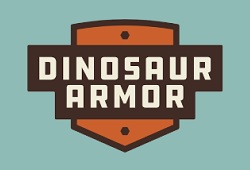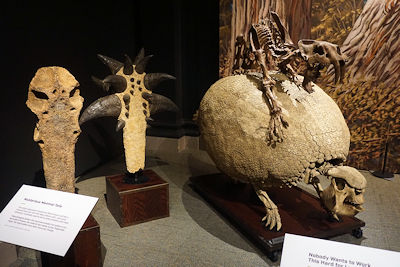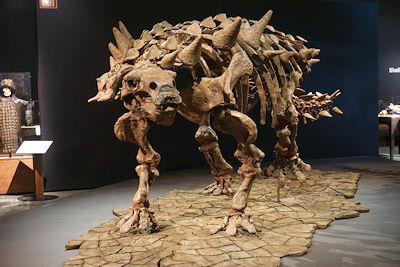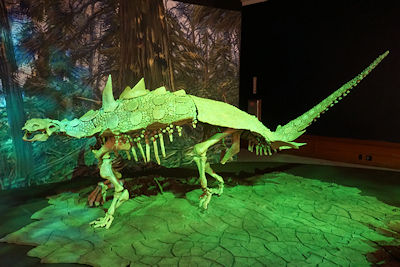
“Welcome ladies, gentlemen to this extraordinary evening,” the auctioneer tells the crowd. “Let’s dive right in with lot number one – the Ankylosaurus. This is an herbivorous quadruped. Late Cretaceous. This is one of the largest armored dinosaurs, known by paleontologists as a living tank. I have four million dollars, anyone with five?”
Within the films of the Jurassic Park franchise, the extinct behemoths of the past have been brought back to life. Although they had once dominated planet Earth, however, the Brachiosaurs and Tyrannosaurus Rex of the present are now specimens in an island-size entertainment park. During the Jurassic World installments of the series, meanwhile, they are even considered weapons of war and – in Fallen Kingdom – auctioned off to the highest bidder.
While the nations of today may crave a “living tank” like the Ankylosaur, the dinosaur’s armored plates and club-like tail were defensive weapons during the Jurassic Age – a form of protection that could intimidate just as easily as inflict damage – as well as a way to attract the opposite gender. In that sense, armored dinosaurs were not unique but a part of the evolutionary process that began in the oceans and extended to every species that inhabited planet Earth.
In June 2020, the Carnegie Museum of Natural History in Pittsburgh launched Dinosaur Armor, an exploration of the defensive body structures that nature developed over the course of hundreds of millions of years that not only features dinosaur fossils but artistic representations – courtesy of Gaston Design – of prehistoric invertebrates, fish, reptiles, and mammals.
“I’m excited about Dinosaur Armor because it showcases extraordinary dinosaurs that have never been seen at the Carnegie Museum of Natural History,” curator Matt Lamanna explained at the exhibit’s premier. “Including tank-like armored dinosaurs called Ankylosaurs and the ferocious Tyrannosaurs and giant Raptors that would’ve tried to bring them down. But this exhibition isn’t about dinosaurs alone. It’s a march through time, through the evolution and diversity of body armor and ornament in myriad prehistoric and modern creatures, from invertebrates to fishes to reptiles to mammals and even ourselves.”
Early lifeforms like fish and invertebrates primarily stayed within one area of the planet’s oceans, but as life continued to expand with each additional species, these new creatures were more mobile and restless. They also evolved into two distinct categories – predator and prey. Since predators had the advantage in regards to strength and size, their prey needed a means of protection and nature complied by granting them thick shells and external skeletons.
While modern day snails, crabs, and turtles still retain their shells and use them to effectively “hide” when threatened, fish developed scales as their main form of natural protection. In addition to acting as armor, scales also reflect light and can be used by fish to camouflage themselves within their surrounding area when under attack.
As large reptiles began to dominate the land, they likewise developed their own sets of armor that was even more diverse than those found in the oceans. The exploration of these reptiles formed the centerpiece of Dinosaur Armor, with genuine fossils and life-size replicas of an Akainacephalus, adult and juvenile Teratophoneus, Peloroplites, a pair of Utahraptors, and two Gastonia.
The Teratophoneus – which means “monstrous murderer” and were related to the T. Rex – and Utahraptors – which, as their name suggests, were raptors that once roamed modern day Utah – are representative of the types of predators that dominated the Jurassic World landscape. Although their agility, speed, and massive jaws made them menacing in their own right, these dinosaurs were outmatched by the strength of the protective outer gear worn by their bulkier, slower-moving brethren.
The Akainacephalus, Peloroplites, and Gastonia are all examples of Ankylosaurs, similar to the one auctioned off in Jurassic World: Fallen Kingdom. They may have been referred to as “living tanks” in the film, but the skeletal remains showcased in Dinosaur Armor demonstrate that they were much more than that in real life. Peloroplites, for instance, means “monstrous heavy one,” and all three species were slow-moving because of the added weight of the protection they carried.
While their lack of speed may have made them appear as easy prey to the Teratophoneus and Teratophoneus, however, their thick armor was difficult to pierce. More importantly, Ankylosaurs did not just have defensive weapons like its skin but offensive weapons in the form of their tails, which were heavy clubs that could inflict just as much damage as the sharp teeth and powerful jaws of dinosaur predators.
Just as ancient fish and invertebrates, as well as later reptiles and dinosaurs, developed defensive characteristics, so did the dominant creatures at the dawn of the Age of Mammals. Their features were similar to those from the past despite belonging to a different scientific classification, a phenomenon called “convergent evolution” – the process in which unrelated lifeforms evolve with similar traits.
Thus the modern day armadillo has an armored shell just like Ankylosaurs while the rhinoceros has defensive horns similar to the Triceratops. The lone exception to this convergent evolution, of course, is the species that came to dominate planet Earth like no other before it – Homo sapiens. But while humans may not have natural body armor, the intelligence of our species has allowed us to learn from other creatures and craft manufactured armor as an alternative.
The Dinosaur Armor exhibit ends with examples of manufactured defensive attire, and relates how each unique civilization learned from the animals within their region and the materials at their disposal. Leather helmets from Germany, porcupine fish helmets from the South Pacific, and metal helmets from Northern Europe were all on display, as well as a suit of crocodile armor from Ancient Egypt.
Contemporary sports often recite the adage that “the best offense is a good defense,” and the same holds true within the Animal Kingdom. Predators may have had their own unique advantages ever since life first began to proliferate but their prey developed their own in response. As Ian Malcolm observed in the original Jurassic Park, “Life finds a way” – an epitaph that holds true for fish and reptiles, dinosaurs and mammals, and even Homo sapiens.
Anthony Letizia





